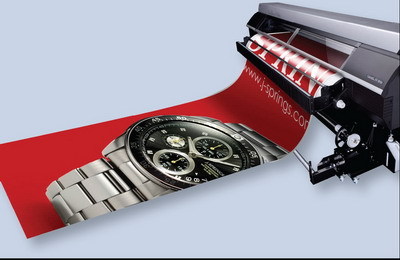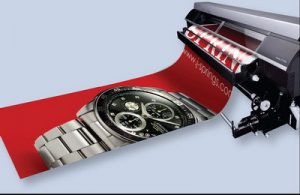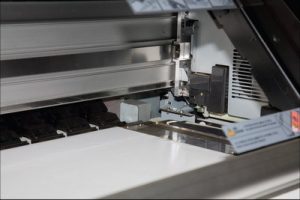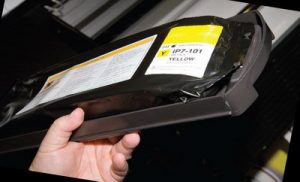Seiko Infotech, with its pair of new, dynamic printers, made a big splash at the Atlanta SGIA ’08. Branded as the Seiko ColorPainter™ H-Series line, these new printers incorporate innovative upgrades, as well as the best features of Seiko’s previous printers. In our opinion, they bring Seiko into the limelight.
The line comprises two models; printing width is the primary difference. The smaller H-74s will handle media widths up to 74 in. wide, and the larger H-104s prints up to 104 in. wide, which qualifies it as a grand-format printer. Both are available in eight-color or four-by-two color configurations.
It also includes Seiko’s new-for-2008, updated printhead that’s designed for both quality and industrial, high-speed production. With eight offset heads per machine, and working in conjunction with Seiko’s Smart-Pass Technology, both systems reduce (and often eliminate) banding. They also ensure precise dot placement.
Fast or fine
Advertisement
Past Seiko-made printers have had two memorable features: fastest in class and saturating (intense) inks. We think the earlier models also produced the best reds in the wide-format printer stable. Seiko now features its EGO-GX mild-solvent ink, which is friendlier than the earlier solvents.
We worried the new inks wouldn’t be as vibrant, but they are. Seiko has maintained the color richness and added a few mystical twists. The ink color’s high intensity is readily apparent.
Further, you can choose between near photographic output or opt for production-quality high speed. How? The printers use a bulk-ink tray and bag system as opposed to the traditional cartridges or boxes; thus, they lodge eight, substantially sized bags of ink. You can install a graphic-art ink mix (cyan, magenta, yellow, black, light cyan, light magenta, gray, and light gray) or two sets of CMYK inks. The dual, CMYK ink set applies the colors twice as fast; it allows production schedules for commercial-grade work.
The graphics-color ink set allows subtle shading and true black and gray shades, at speeds up to 538 sq. ft./hr. Several steps are required to switch color configurations; thus, the manufacturer recommends you choose the configuration prior to ordering the printer.
In the fine-quality, graphics-arts normal mode, 720 x 720 dpi will produce 323 sq. ft. per hr. Trigger the dual, CMYK array, and achieve 645 sq. ft. per hr. (720 x 720 dpi, eight pass). If that’s not fast enough and the output is to be viewed from a distance, switch to draft mode (720 x 360 dpi, four pass). The speed increases to an incredible 1,075 sq. ft. per hr.
Advertisement
Once again, Seiko has maintained its blazing speed.
As we watched the printer’s high-speed action, we remembered that earlier Seiko printers needed an optional dryer, to dry the prints before they spooled into the take-up reel. We soon learned the new inks have faster drying characteristics – no auxiliary dryer is needed.
Usability improvements
If only for the speed and print-quality improvements, we’d surely award a gold star, but additional features also enhance the ColorPainter machine as an attractive choice:
• Seiko offers 2, 1.5-liter ink bags, and its sub-tank setup is easy to install and replace.
• The H-Series ColorPainters have an integral, media-thickness sensor that automatically adjusts head height to the optimal setting for the selected, print-quality mode. The printers handle various media – from thin films to banner material.
Advertisement
• The control panel is upfront; other improvements include automatic head cleaning and an improved capping station.
Do you print on unlined mesh? Order the optional, ink-catch tray. Do you print double-sided images? Order the optional double-sided print kit. Want better venting? Order the optional exhaust attachments. Like efficiency? Order the optional foot-control pedal.
Media handling
To sustain production print demands, Seiko incorporated a heavy-duty media-handling and take-up system. It secures up to 264 lbs. of loaded media in roll diameters up to 13.8 in.
Conclusion
Seiko’s new ColorPainter family carries on its vibrant-color and blazing-speed tradition. The $59,995 H-74s will probably handle most jobs encountered by a mid-sized signshop, but if your shop needs extended print widths, the $79,995, H-104 is your call.
If you need print quality, speed and reliability, examine this competitively priced machine. Remember, you can also print near-photo-quality images – and production prints – on the same machine. It’s like getting two printers for the price of one.
Key Information
Seiko I Infotech — Americas, 2060 Wineridge Pl., Escondido, CA, (760) 781-5200
Contact: Trish Kinman, marketing manager, (760) 781-5200, ext. 100, tkinman@seiko-i.com
Company Profile: Seiko I Infotech Inc. (SIIT) was formed by the merger of Electronics Instruments Division of SII and SII-affiliated companies; the new firm became a division of Seiko Instruments USA Inc. Seiko I Infotech’s product lines include narrow- and large-format digital printers in such technologies as laser, LED, electrostatic, dye-sub and solvent-based, digital printing.
System Requirements: A 200- to 240VAC line (expect the printer’s heater to consume 2000W). The machine’s operating range is 59° to 86° F, within a 30 to 70% range of relative humidity. The printers come with a USB 2 connection for the system interface.
At a Glance: Seiko’s ColorPainter H-Series line incorporates innovative ugrades and the best features of its previous printers. The line also includes Seiko’s new printheads.



 Tip Sheet1 week ago
Tip Sheet1 week ago
 Photo Gallery2 days ago
Photo Gallery2 days ago
 Ask Signs of the Times4 days ago
Ask Signs of the Times4 days ago
 Real Deal1 week ago
Real Deal1 week ago
 Benchmarks6 days ago
Benchmarks6 days ago
 Women in Signs1 week ago
Women in Signs1 week ago
 Photo Gallery1 week ago
Photo Gallery1 week ago
 Women in Signs1 week ago
Women in Signs1 week ago












